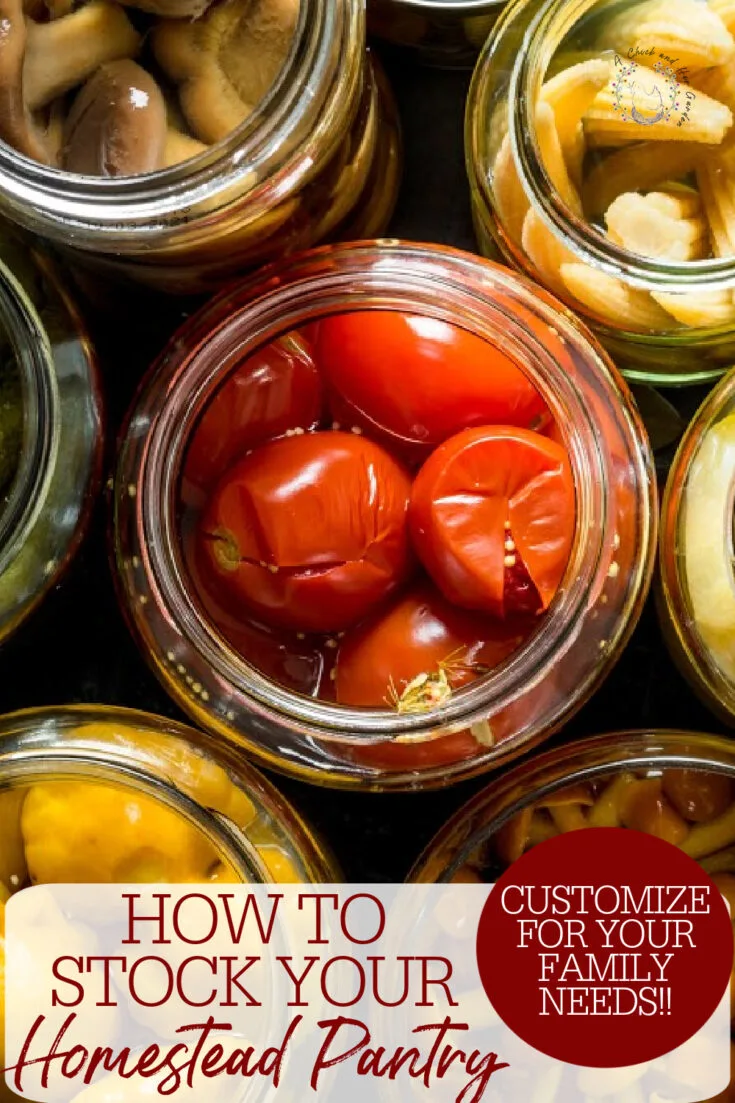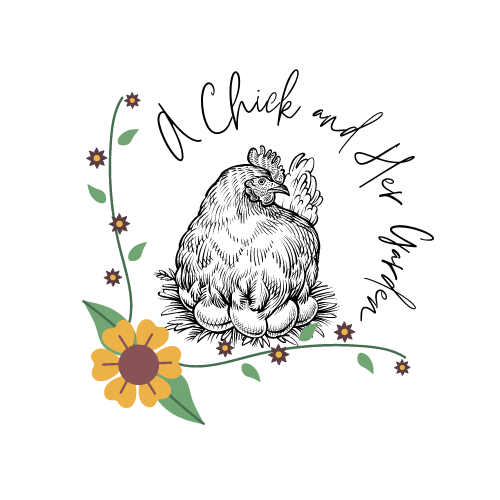How to stock your homestead pantry, and what to do if it starts to run dry?
Let’s admit it, we all have this vision when we start a homestead lifestyle of a beautiful pantry. It’s full to the brim with beautiful jars, filled with every shelf stable item our family would need, for an entire year!
Even if you’re not really sure how to stock your homestead pantry.
Well, that is the goal isn’t?

This page may contain affiliate links. I may earn a small commission when you make a purchase, but it does not effect your cost. Thank you so much for your support of A Chick And Her Garden! ~ Staci
But the reality is that our newly established homesteads do not come with a fully stocked pantry. And for a lot of us the skills needed to harvest, let alone preserve that food will come with time.
Am I saying this to deter you from your dream? Absolutely not!
Pin Me For Later!!

I’m actually saying it so that you do not feel completely crushed when your pantry isn’t exactly what that post said it should be. I want you to feel accomplished with each step you take towards a more sustainable lifestyle!
I see a lot of posts on how to stock your homestead pantry with a years worth of food. And truly, I do love them!
But not because I think that my pantry will look like that the first, tenth, or even 20th year of homesteading.
I love these posts because they help me set my own goals!
We all have different family structures, are at different stages of our homesteading skills, live in different climates, not to mention a slew of other factors that determine how you stock your homestead pantry.
So what are some steps you can take to have your dream pantry?
Let’s start by making a list. It’ll be easy, I promise!
Think about what foods your family loves and what they can live without, for now. Most of our preservation will hopefully, eventually, come from our own gardens.
But realistically, our gardens will not have everything on the list in the first year! If you try, you might succeed, but more than likely it will lead to you being overwhelmed and have a failing garden.
Related Posts:
- How to Make Money on the Homestead
- How to Make Goat Cheese, Chèvre
- Homemade Butter Without a Churn
- The Ultimate Kitchen Cleaning Checklist
- How I Hacked My Swiffer And Saved $500 A Year
- Pressure Canning Straight From A Newbie
Not good! Remember, I want you to succeed!
So now, take your list and look at what is most feasible for you in the garden. This is your starting point.
I know it’s really hard when you look through seed catalogs or walk up and down the aisle’s at a greenhouse, to not want to grab a little bit of everything. (Been there!) Don’t cave to temptations!
Make a new list of just these plants you want to grow and what you need to grow them. My seed starting checklist is really helpful with this!
How does your garden grow?
Honestly, you could have all of your crops turn out, or just one. Guess what? Do a happy dance anyway!
You grew that food! It’s feeding your family. GO YOU!
In the mean time though, research what options you have to preserve that harvest. Will you freeze it? Will you can it? Does it need a pressure canner or can it be done in a water bath?
Stock up on canning jars and lids you will need throughout the summer (or right now, through these affiliate links!), because it can be a serious pain to go to the store and find out they are out of the size you need.
Not to mention it can be a bit of a shocker if you purchase them all at once! (Remember these expenses are worth it in the long run!)
If you’re growing tomatoes will you be making pasta sauce, plain sauce, canning the whole tomato, making ketchup? Think about how much of these you go through as a family, and what size you typically use for your recipes.
The time you have through the summer to plan this will keep you from some serious headaches in the fall, I guarantee it!
Here are some other great tools for the homestead kitchen!
So Your Favorite Crop Didn’t Turn Out…
Does this mean that your bound to the supermarket until next season? NO! You can still find ways to put that in your pantry!
Did you have a great crop of apples and your neighbor had tomatoes?

Suggest a trade.
Go to a wholesale market.
Or if you luck out like me, I called a produce stand by me that told me a bushel of tomatoes was $18. When I showed up that “bushel” weighed at least 50 lbs! (I bought 3!)
Explore your area, they will have resources that you can utilize! Think out of the box!
I’m not saying go and buy everything you want in your pantry and try to preserve it all at once! Like I said before, you will learn the skills along the way.
Some great skills to practice before garden season gets into full swing would be preserving soups and stocks. Check out my post on pressure canning chicken stock !
You’ll figure out how to stock your homestead pantry! Take your time and make it your own!
So you’ve done it! You’ve preserved your crops!
You gave yourself an idea of what you needed when you made your list. Was it exact? Probably not. Menus change and people crave something different. At least that’s how it goes in my house.
This is why I emphasize that this post is how to stock your homestead pantry!
Hubby could go on a meatball hoagie kick and clean me out in no time. Or he could decide he doesn’t like applesauce anymore and I’m left with 20 jars that I can’t finish on my own!
In the beginning, we run out or have too much. Make a note of that and plan for more or less next year.
Now, should you run to the store? Maybe not.
Take a look at what you do have and see if you can make it work!
I ran out of plain tomato sauce this week. Seriously?! Gasp! That’s a pretty important staple around here!

But what I do have is tons of tomato paste! Can I make it work? You bet I can! To make tomato paste into sauce you just re-hydrate it.
Yeah yeah, I know, it’s not dehydrated. What I mean is heat it and add water until you find the consistency you need. It took me about 1 and 3/4 jars water to 1 jar of paste.
Learning how to stock your homestead pantry is not an exact science. It is a learning curve. It all depends on your skills, your family needs, and even luck!
As you and your homestead grow, so will your pantry! Do not get discouraged! Use everything as a learning experience!
Looking for some inspiration for your pantry? Here are some of my must haves!
- Cinnamon Applesauce
- Apples and Bananas Fruit Roll Ups
- Chicken Stock
- Homemade Taco Seasoning In Bulk
- Onion Powder
- Spicy Dilly Beans
- Canned Tomatoes
- Homemade Peppered Linguine
Here are some tools that you will need when stocking your pantry!
- A water bath canner is perfect for high acidic foods like tomatoes, applesauce, and pickled items!
- A pressure canner is used for the low acidic foods like beans, corn, meat, or even stocks and soups! (I like this one because the electric ones can have their coils burn out.)
- A dehydrator to preserve fruit chips, make jerky, make your own onion powder or garlic powder, or dry herbs!
- The Ball Complete Book of Home Preserving, which is full of regulations, tips and recipes!
- Of course you will need jars and lids!
- Some recipes will call for Citric Acid, especially tomato products.
Those are some of my must have pantry tools! If you’re curious about other resources I use for my homestead and blog, check out my Recommendations Page!

Susan Godden
Thursday 17th of January 2019
Great article. Thank you so much!
Anne Inthekitchen
Saturday 8th of April 2017
This post is terrific! I love the doses of reality that help shape dreams, without crushing them. It's easier to be successful, when you have a realistic definition of success to start with! Thanks for sharing!
Staci Samuels
Friday 14th of April 2017
Thank you so much Anne!
Piwakawaka Valley
Friday 7th of April 2017
you make your own tomato paste? How? please do tell!
Anne Inthekitchen
Saturday 8th of April 2017
It's kind of a cheat, but after I peel a ton of tomatoes I dehydrate the peels. Then, I blitz the dried peels in my food processor until they are powder. I rehydrate as needed with just enough water to get the consistency of tomato paste. (The powder is also great for thickening dishes and adding flavor/nutrition to soups and stews. It's probably not the right way, but it works for us and it uses up one more scrap. If I grew the 'maters, I REALLY don't like wasting a bit!
Staci Samuels
Friday 7th of April 2017
I hope to do a post on it this fall, but basically after peeling and seeding your tomatoes you just cook them down until you get to the consistency of tomato paste! Super easy!